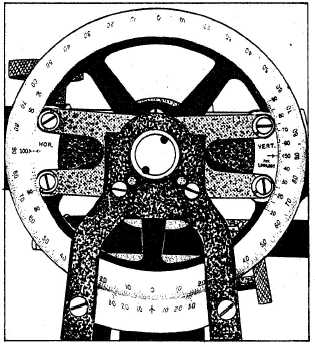The A vernier is used when the telescope is in its
normal position, and the B vernier is used when the
telescope is plunged.
The VERTICAL CIRCLE of the transit (fig. 11-
10) is fixed to the horizontal axis so it will rotate with
the telescope. The vertical circle normally is
graduated to 30´ with 10° numbering. Each quadrant
is numbered from 0° to 90°; the 00 graduations define
a horizontal plane, and the 90° graduations lie in the
vertical plane of the instrument. The double vernier
used with the circle is attached to the left standard of
the transit, and its least reading is 1´. The left half of
the double vernier is used for reading angles of
depression, and the right half of this vernier is used
for reading angles of elevation. Care must be taken to
read the vernier in the direction that applies to the
angle observed.
In addition to the vernier, the vertical circle may
have an H and V (or HOR and VERT) series of
graduations, called the STADIA ARC (fig. 11-10). The
H scale is adjusted to read 100 when the line of sight
is level, and the graduations decrease in both
directions from the level line. The other scale, V, is
graduated with 50 at level, to 10 as the telescope is
depressed, and to 90 as it is elevated.
29.266
Figure 11-10.-Vertical circle with verniers,
scales, and stadia arc.
The VERNIER, or vernier scale, is an auxiliary
device by which a uniformly graduated main scale
can be accurately read to a fractional part of a
division. Both scales may be straight as on a leveling
rod or curved as on the circles of a transit. The
vernier is uniformly divided, but each division is
either slightly smaller (direct vernier) or slightly
larger (retrograde vernier) than a division of the
main scale (fig. 11-11). The amount a vernier division
differs from a division of the main scale determines
the smallest reading of the scale that can be made
with the particular vernier. This smallest reading is
called the LEAST COUNT of the vernier. It is
determined by dividing the value of the smallest
division on the scale by the number of divisions on
the vernier.
Direct Vernier.— A scale graduated in
hundredths of a unit is shown in figure 11-11, view A,
and a direct vernier for reading it to thousandths of a
unit. The length of 10 divisions on the vernier is
equal to the length of 9 divisions on the main scale.
The index, or zero of the vernier, is set at 0.340 unit.
If the vernier were moved 0.001 unit toward the
0.400 reading, the Number 1 graduation of the
vernier shown in figure 11-11, view A, would coincide
with 0.35 on the scale, and the index would be at
0.341 unit. The vernier, moved to where graduation
Number 7 coincides with 0.41 on the scale, is shown
in figure 11-11, view B. In this position, the correct
scale reading is 0.347 unit (0.340 + 0.007). The index
with the zero can be seen to point to this reading.
Retrograde Vernier.— A retrograde vernier on
which each division is 0.001 unit longer than the 0.01
unit divisions on the main scale is shown in figure 11-
11, view C. The length of the 10 divisions on the
vernier equals the length of the 11 divisions of the
scale. The retrograde vernier extends from the index,
backward along the scale. Figure 11-11, view D,
shows a scale reading of 0.347 unit, as read with the
retrograde vernier.
Vernier for Circles. — Views E and F of figure
11-11 represent part of the horizontal circle of a
transit and the direct vernier for reading the circle.
The main circle graduations are numbered both
clockwise and counterclockwise. A double vernier
that extends to the right and to the left of the index
makes it possible to read the main circle in either
direction. The vernier to the left of the index is used
for reading clockwise angles, and the vernier to the
right of the index is used for reading
11-18

